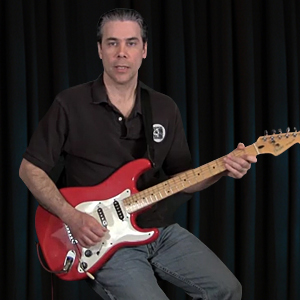Description
In this first lesson we'll look at tremolo picking on the high E string in order to gain control over the alternate picking technique required to play fast lines. Start on the high E string playing the highest A note. Use alternate picking to graze lightly over the string. It helps to angle the pick in order glide or graze smoothly over it. Try not to dig in too much. Try to minimize your motion. As soon as you strike the string, stop, then reverse direction. In order to play fast you have to minimize your motions as much as possible and make then efficient.
It's also crucial to remain relaxed. Any amount of tension in your body, shoulder, arm, fingers is going to make it harder to play fast at all or for any length of time. Stay relaxed and loose! Play with minimal motion, but smooth, natural and efficient motion. You can alternate pick from the elbow, the wrist or the fingers. You can use some combination of 2 or these or all 3. But stay relaxed and loose.
Find a good tempo at which you can maintain a constant stream of evenly spaced notes. When you are comfortable with tremolo picking try to add changing notes! We'll try just 3 notes from the A minor scale, then 3 notes from the A major scale. I suggest to students to go as fast as you can but still keep the notes evenly spaced in time. In order to do this, use a metronome. That way you can get an objective measurement of exactly how fast you can play in order to benchmark and keep track of your progress. If you start to get uneven spacing, then it's time to slow down the tempo. You have nothing but time to practice getting faster gradually!
This is a crucial step in developing speed. The very simple, but highly effective, idea is to start by playing each note more than once using the tremolo picking technique in order to get the picking technique under control along with the the scale patterns memorized. This process accomplishes a few things at once.
1. It gives you a lot of practice at alternate picking.
2. It helps in memorizing scale patterns, hand positions and motions.
3. It helps in co-ordination and synchronization of your picking hand and fretting hand.
By dwelling on each note more than once, also, you are not required to move your fretting hand fingers so often. You are in effect "slowing down" a fast lick, but still playing fast.
Lesson Info
Tutorial Lessons
- Building Speed: Introduction
- Tremolo Picking Technique
- Tremolo Picking Technique Play Along
- A Minor Scale Tremolo Picking
- A Minor Scale Tremolo Picking Play Along
- A Major Scale Tremolo Picking
- A Major Scale Tremolo Picking Play Along
- A Minor Scale In 4s
- A Minor Scale In 4s Play Along
- A Major Scale In 4s
- A Major Scale In 4s Play Along
- A Minor Scale In 6s
- A Minor Scale In 6s Play Along
- A Major Scale In 6s
- A Major Scale In 6s Play Along
- Speedy Ideas 1: Conclusion
